DFF1-UHD Sounder
The "Furuno Sounder Module" needs to be unlocked prior to configure a Furuno Ethernet Sounder in TimeZero.
Introduction
TimeZero can be connected to a NavNet network that includes an MFD (TZtouch/TZtouch2/TZtouch3) and a DFF1-UHD or TimeZero can be connected directly to a DFF1-UHD (without any MFD on the network).
When there is no MFD on the network, and if you want to use the Heave Compensation feature of the sounder, TimeZero will need to be connected to a Furuno Satellite Compass (in order to provide Heave, Pitch and Roll information to the sounder). If there is an MFD on the network, connect the Furuno Satellite Compass to the MFD (which will be in charge of sending Heave, Pitch and Roll information to the sounder).
Computer Setup
The DFF1-UHD connects to the PC through an Ethernet connection (100Base-T). All the Furuno Ethernet sensors (including Ethernet sounders) only operate on the 172.31.x.x / 255.255.0.0 network. You will have to setup your computer IP address to match that network. We highly recommended using 172.31.3.150 as a fixed IP address for the computer with a subnet mask of 255.255.0.0.
Open the "Network Connections" control panel of your computer to adjust the IP address. Under Windows 10/11 you can press the combination shortcut Windows Key + R to open the Run dialog box. Type "ncpa.cpl" and click on "OK":
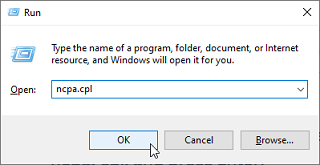
Double click on the Network Adapter connected to the sounder (usually “Local Area Connection”).
Note: If you have multiple Area Connections (multiple Ethernet Cards) and if you don’t know which one is connected to the sounder, you can temporary disconnect the Ethernet Cable connected to the sounder from the computer and look at which icon will display a red cross. This will indicate the LAN that has been disconnected from the computer, and thus the one that needs to be configured.
Select "Properties" on the "Local Area Connection Status" window. Double click on “Internet Protocol Version 4 (TCP/IPv4)”. Use the fix IP address 172.31.3.150 with a subnet mask of 255.255.0.0:
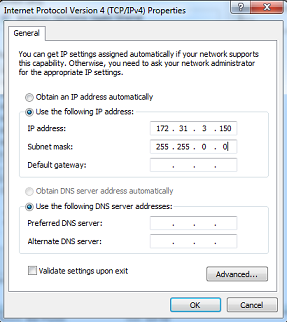
If the DFF1-UHD is directly connected to the computer, make sure that the DFF1-UHD is set for the fix IP address mode. Open the DFF1-UHD cover and make sure that the “S2” DIP Switches 1 and 2 are set to the OFF position (all DIP Switches should be in the OFF position):
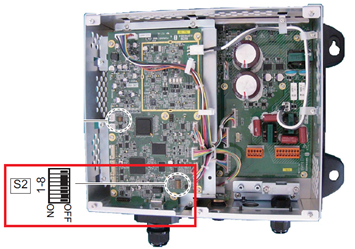
Connect the DFF1-UHD to the computer (directly or via a HUB/Switch).
Note: You can "Ping" the DFF1-UHD from the computer to make sure that the connection in between the computer and the sounder is OK. The address of the DFF1-UHD to ping is: 172.31.92.2. For more information on how to ping an Ethernet device, refer to the How To Ping chapter.
IMPORTANT TD-ID (XID) INFORMATION: In some instance the TD-ID (XID) wire (orange wire connected to PIN 3 of TB4 connector) can cause problem. It is recommended to disconnect the orange wire and proceed to a Master Reset of the Sounder (see at the end of this chapter). After performing the master reset, follow the instructions below to manually set the transduce settings.
TimeZero Settings
Open TimeZero in Navigation mode, select the Sounder Options and make sure that the "DFF1-UHD" is set as a Fish Finder Source.
Click on the “Transducer Setup” button. Select "Model" and select the corresponding transducer model:
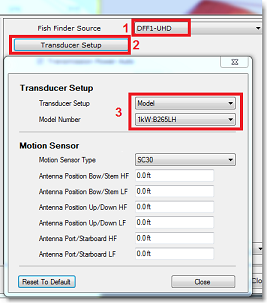
IMPORTANT TRANSDUCER INFORMATION: We recommend using the Airmar transducer B265 or CM265 with the DFF1-UHD. Other “Low High” CHIRP transducers such as the 175LH, 109LH or 509LH may be used, however the accuracy of both ACCU-FISH and Bottom Discrimination modes will not be guaranteed. In this case, put the transducer settings to “Model Number” and select “B265LH”. Please refer to a Furuno dealer for more information on the DFF1-UHD sounder and compatible transducers.
If you want to use the Heave Compensation, make sure to select the corresponding Satellite Compass which is connected to TimeZero (or to the MFD) and enter the various offsets using the coordinate system below (origin is the transducer):
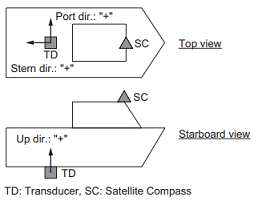
Enter the distance between the transducer(s) and the Satellite Compass antenna. For the Bow-Stern direction, enter a negative value if the transducer is located on the aft side of the Satellite Compass (like in the picture above). For the Port/Starboard direction, enter a positive value if the transducer is located on the starboard side of the Satellite Compass.
Note: If you are using a SCx20 Furuno Satellite compass, select "SC30".
Once you are done with the transducer settings, click on "Close" to validate the setting and close the transducer setup window.
After doing any change to the Transducer Setup window, the DFF1-UHD needs to be restarted (to lock the settings in the DFF1-UHD memory). Exit TimeZero then unplug and plug back the DFF1-UHD power cable. Restart TimeZero.
Select the Sounder Options again and make sure to adjust the "Transducer Draft" under "Sounder Initial Setup". Make sure to also adjust the proper "Temperature Port". Most transducers have a built in temperature sensor and the information is sent through the transducer cable. In that case, select "Low Frequency" for "Temperature Port" selection. If you have an independent temperature sensor connected to the "MJ" port, select "MJ".
Close the TimeZero Options and select the Sounder WorkSpace: you should see the sounder picture scrolling on the screen. Adjust the Sounder Range to get a good view of the bottom (it is recommended to set the mode to Auto Fishing).
Note that the depth, temperature and speed data is sent to TimeZero via the Ethernet connection on the NavNet NMEA port. Follow the instructions below to configure the NavNet port:
-
Select "Connection Wizard" that can be found under the "TimeZero" button
-
Select "Manual Port Configuration" from the Connection Wizard
-
Select "Add/Configure NavNet Connection" and click on "NMEA & AIS"
-
Make sure that at minimum "Depth" is checked for the "NavNet NMEA" port. If the transducer has a Speed and/or Temperature sensor, make sure to select the appropriate data:
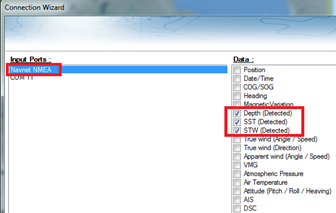
Note: In some instance, when the DFF1-UHD is connected to a transducer without speed sensor, it will still send a wrong "STW" value (that will always be set to 0). In that case, make sure to uncheck "STW" from the Connection Wizard.
-
Click on "Next" and "Finish" to close the Connection Wizard
If you want to use the Heave Compensation feature, make sure TimeZero has been configured to receive Heave, Pitch and Roll from the Connection Wizard (you can display these values in a NavData to confirm proper configuration.
Advanced Troubleshooting
"Power OFF" Message
If TimeZero display “Power OFF” on the Sounder WorkSpace or you see no echo at all, it means that the sounder is not recognized on the network. Check the IP address of the computer (make sure the subnet mask is set to 255.255.0.0) and check the cable(s). You can "Ping" the DFF1-UHD from the computer to make sure that the connection in between the computer and the sounder is OK. The address of the DFF1-UHD to ping is: 172.31.92.2. For more information on how to ping an Ethernet device, refer to the How To Ping chapter.
"Blank" Screen (no echo even when gain is set to maximum):
If TimeZero displays a "blank" (empty) screen even after changing the Transducer Setup and restarting the DFF1-UHD, it is recommended to remove the orange wire (XID wire), perform a Master Reset of the DFF1-UHD and try the configuration again. To perform a Master Reset of the sounder:
-
Disconnect the DFF1-UHD from the network and power it OFF (remove power)
-
Remove the DFF1-UHD cover (leave the Sounder OFF)
-
Set the “S2” DIP switch No. 4 to ON (while the sounder is OFF)

-
Power ON (connect power) the Sounder and wait 1 minute or two minutes
-
Power OFF the sounder, set DIP switch number 4 back to the OFF position
-
Connect the DFF1-UHD back to the network
-
Power ON the Sounder and confirm that the LED blink fast (twice per second) after 1 minute of boot up
-
Start TimeZero and configure the Sounder Transducer settings from the “Sounder” Options
-
Close the Options window and exit TimeZero
-
Restart the DFF1-UHD (disconnect and reconnect power)
-
After 1 minute, confirm that the DFF1-UHD led blink slowly (once every 2 seconds)
-
Start TimeZero
Bottom Discrimination not working:
If you cannot see the Bottom Discrimination data (after enabling the feature from the "Sounder" button located in the Ribbon), check the following points:
-
The DFF1-UHD will ONLY send Bottom Discrimination data when the depth below transducer is over 5 Meters (17 Feet). If you are configuring the sounder at the dock with less than 5 meters of water, the bottom discrimination data will NOT appear. You will have to perform a sea trial. It is recommended to restart the DFF1-UHD (cycle the power) at least once in depth over 5 meters.
-
Bottom Discrimination data will ONLY work with selected Transducers. For example, the bottom discrimination will NOT work with the B275LH-W. Please contact your Furuno dealer for compatible transducer.
-
Bottom Discrimination data will ONLY work if the Transducer Setup has been set to "Model Number". "TD-ID" is NOT recommended. In some instance, it appears that the TD-ID configuration is not sending proper transducer information to the DFF1-UHD. In these cases, the TD-ID wire of the transducer needs to be disconnected to allow the transducer to be manually selected to the specific model. Remove the TD-ID orange wire which is connected to PIN3 of the TB4 connector. Once the orange wire has been removed, restart the DFF1-UHD and TimeZero, then set the Transducer Setup by Model Number and pick the corresponding Transducer Model.